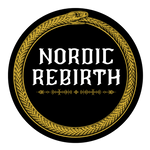
Bind Runes
A bind rune (Icelandic: bandrún) is a ligature of two or more runes. They are extremely rare in Viking Age inscriptions, but are common in earlier (Proto-Norse) and later (medieval) inscriptions.
On some runestones, bind runes may have been ornamental and used to highlight the name of the carver.
There are two types of bind runes. Normal bind runes are formed of two (or rarely three) adjacent runes which are joined together to form a single conjoined glyph, usually sharing a common vertical stroke (see Hadda example below). Another type of bind rune called a same-stave rune, which is common in Scandinavian runic inscriptions but does not occur at all in Anglo-Saxon runic inscriptions, is formed by several runic letters written sequentially along a long common stemline (see þ=r=u=t=a=ʀ= =þ=i=a=k=n example shown above).[4] In the latter cases the long bind rune stemline may be incorporated into an image on the rune stone, for example as a ship's mast on runestones Sö 158 at Ärsta and Sö 352 in Linga, Södermanland, Sweden, or as the waves under a ship on DR 220 in Sønder Kirkeby, Denmark.
And don't forget even the Bluetooth symbol is one as well!
Bindrunes are a type of runic symbol created by combining multiple runes from the Elder Futhark, which is the oldest known runic alphabet used by the Germanic peoples. Bindrunes were believed to have magical properties and were used in various forms of divination, protection, and spell-casting.
To create a bindrune, you start by selecting the runes that represent the desired qualities or intentions. The runes are then combined into a single symbol, with each rune overlapping or intersecting with the others to create a unique design. The resulting bindrune symbol is said to be more powerful than the individual runes used to create it.
Here are some examples of Nordic bindrunes in the Elder Futhark and their meanings:
-
The Viking Compass: A bindrune made up of eight different runes, representing different aspects of protection and guidance. It was believed to offer guidance and protection to those who wore it.
-
The Helm of Awe: A bindrune made up of eight different runes, representing courage, strength, and protection. It was believed to offer protection against enemies and danger.
-
The Love Bindrune: A bindrune made up of two different runes, representing love and harmony. It was believed to help attract love and strengthen relationships.
-
The Wealth Bindrune: A bindrune made up of four different runes, representing wealth, prosperity, and abundance. It was believed to attract money and financial success.
These are just a few examples of the many different bindrunes that were created and used by the Nordic peoples. Each bindrune was unique and had its own specific meanings and uses.

